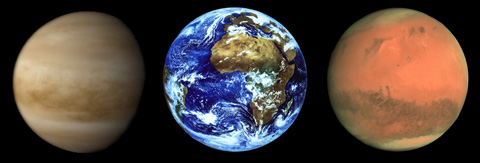This article is more than 1 year old
Filtering starlight to probe new worlds
In the solar system and beyond
Interview European star gazers have been filtering stellar light through the atmospheres of the three inner planets to find out what they are made of.

Venus Express, the European Space Agency's (ESA) mission to our twin planet, is watching starlight as it passes through Venus' thick swirling atmosphere for the first time.
The technique, known as stellar occultation, involves watching a star as it drops behind a planet, and measuring its light before it drops below the horizon. It can give scientists a profile of the molecules present in the atmosphere, by allowing a comparison between the unfiltered and filtered starlight.
Boffins focusing closer to home have used the technique to study Earth's atmosphere, and have been tracking the health of the ozone layer. While they say it is still too early to say whether or not the protective zone is recovering from decades of CFC abuse, they have learned plenty about other things that influence the tenuous layer.
For instance, in a paper* published this February, researchers describe watching a layer of nitrogen dioxide build up over the poles early in the year, and later sink towards the Earth, wiping out the ozone in its path.
Stellar occultation is also useful on Mars, although we don't often think of the red planet as having much of an atmosphere. A simplified instrument on board Mars Express has tracked the light of a thousand stars passing through Mars' wispy atmosphere, and has provided researchers with almost all the data they have on its upper layers.
Jean-Loup Bertaux, the scientist who first proposed using the technique on an ESA mission, describes the trick as "combat proven", adding that it "should be useful for further long-term studies".
We had a quick chat by email with Bertaux, and asked him about the potential this technique has to add to missions both current and future:
Reg: Is it being considered for inclusion on further missions? Could we use it to discover more about Titan, for instance, using the kit already in space?
Bertaux: There are some plans to continue the monitoring of terrestrial ozone by this technique, namely a Belgian project named "ALTUS".
On board Cassini (in orbit around Saturn), the UVIS instrument has some capability to perform stellar occultations. I do not know if they have tried it on Titan, but I know they have used this technique to identify water vapour ejected from satellite Enceladus.
Reg: Do some stars make better "torches" than others?
Bertaux: Brighter stars are of course preferred, the stronger star signal giving a better accuracy on the retrieval of absorbing species.
In the case of terrestrial ozone, we use Ultraviolet rich stars to measure ozone at high altitude above 40km (where there is less ozone, but ozone absorbs a lot in UV: that is this property which we like with ozone to protect us from solar UV). But to measure ozone below 40km, we use all types of star, and we use the absorption of ozone in the visible range.
Reg: Is this something scientists are refining as a technique to help the hunt for extra solar planets?
Bertaux: Actually, the COROT spacecraft is using this very technique to detect some extra-solar planets. The configuration is, however, slightly different.
While we use the absorption of the atmosphere which is rather near the spacecraft for a standard stellar occultation, COROT stares at a large number of stars at once and monitors the brightness. A slight decrease of brightness occurring at regular time intervals reveals the presence of a planet passing in front of the star, occulting a small fraction of the stellar flux.
The smaller the planet, the smaller the fraction of light occulted, with about two per cent dimming for a giant planet the size of Jupiter. ®
*Large increase of NO2 in the north polar mesosphere in January-February 2004: Evidence of a dynamical origin from GOMOS/Envisat and SABER/TIMED data', from the Geophysical Research Letters on 16 February 2007.
